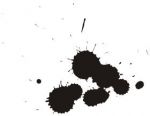Inks

Word “ink” in Russian language “chernyla” derives from”cherny” that means “black” as in the case of Sweden – bläck, in Finland – muste. However, colored inks (not only that of black) are known from ancient times.
For a long time up to the mid-XX century ink was a distinct material. It was kept in special reservoir, an inkpot, where the person who wrote put in his pen.
It is hard now to find out what was the first ink made of, but Egyptians and Chinese are known to use combination of oil and smut. By the time ink appeared in Europe, it had already been common to Greece and Rome.
Red ink produced in Ancient Rome from purpura with cinnabar was claimed “court” since it was used only in writing state documents. There existed the paper which prohibited to use the ink outside the emperor palace, violators could be imposed with death, the ink itself was safeguarded.
Expensive and valuable was the ink produced from gold and silver. In Sweden Upsal University is safe kept “silver bible”, written in silver ink on red parchment. The bible accounts for thousand and hundred years already.
Complicated technological process of producing paint as well as its superior quality became the main reason of expensive price on purpura and, consequently, on ink. Artists of Ancient Rome elaborated ink from fruit pits, vine, soft wood, smut, char and bone coal. Nowadays best black paint is made of smut produced of fired grape pits.
Time passed and ink began to be produced from decoction of smoke-tree rind. Amalgam of smut and gum (cherry paste) diluted with water was called “smut ink” one of the oldest Russian methods to get ink. Receipts “boiled ink” and “ferrous ink” became popular in XV and XVI accordingly and are still very important nowadays. Besides, XVI century knew one more method of producing ink on ink nuts.
With introduction of green vitriol in ХVIII century speed of ink elaboration had increased a lot, this ink was named “good ink”. In 1847 professor Friedlib Ferdinand Runge, German chemist made ink of sandal wood common to tropics. Best type of national ink was navy-blue ink “Pegas”. Blackberry, elder-berry, shells of walnuts and green chestnuts these all served for ink production.
In 1938 Laslo Biro gor a patent for a project of pen with ink delivered to the writing ball under the pressure of bucket. Later in Austria liquid ink was replaced by ink paste, quickly drying up.
These days ink production includes the following chemical substances:
- Solferino (magenta): often used for producing pens
- Oxalic acid (ethane diacid ): used in textile and leather industries as a mordant
- Indigo: serves as vat pigment, is a large tonnage product, major part of which vats fiber of jeans textile
- Methyl violet employed not only in ink production but as well in tinting slips of typewriters along with wool and silk coloring
- Ferric sulfate : applied in textile industry, agriculture as insecticide for preparation of mineral colors
- Indigo carmine: applied for food products, a chemical indicator for producing inks.
In our times we ace inks mostly in computer devices, printers. In this field large classification is provided.
Despite innumerous inventions many people continue to use liquid inks and fountain pens, but this is a personal choice.
返回目录


